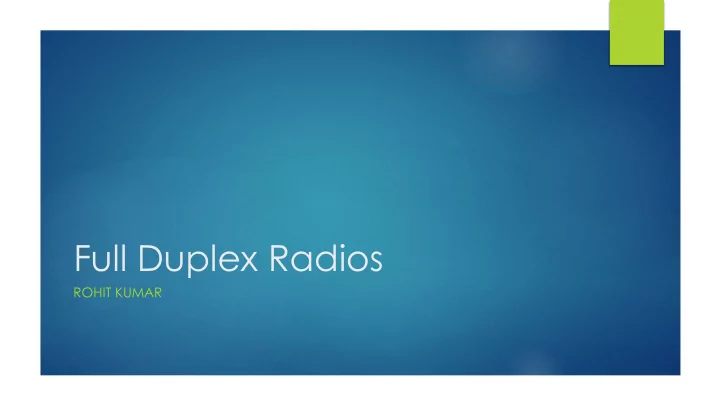

Full Duplex Radios ROHIT KUMAR
2 Types of Communication Simplex – Data can be transferred only in one direction. ▶ Half – Duplex – Data can be transferred in both directions but not ▶ simultaneously. Full – Duplex – Data can be transferred in both directions ▶ simultaneously.
3 Current State of Radios Conventional half duplex wireless systems ▶ rely on transmitting and receiving in different time slots (TDMA) or frequency sub carriers (FDMA). Demand for telecom services is booming, ▶ but radio spectrum is limited. Have to do more with less, design radios ▶ with greater spectral efficiency . Solution is full duplex radio, which ▶ promises doubling the data rate in comparison to its half duplex counterpart.
4 What are Full Duplex Radios (FDR) Radios which simultaneously transmit and receive at the same ▶ frequency/time slot. Theoretically, promises doubling of throughput over half-duplex radios. ▶ Key challenge to achieving FD performance is Self-Interference (SI) , ▶ which is the transmitted signal being added to the receive path of the FD node. Thus, the main objective for FD design is to reduce the strength of SI as ▶ much as possible – ideally, down to noise oor.
5 Advantages Throughput gain : Nearly doubles the throughput of a single-hop wireless ▶ link in the physical layer. Solving hidden terminal problem : FD avoids unnecessary packet drops ▶ due to hidden node problem. Reducing congestion with the aid of FD MAC scheduling : Aggregate ▶ network throughput is increased while simultaneously benefitting from spatial diversity gain. Reduces end-to-end delay in mesh networks : As a relay, FD radio can ▶ simultaneously transmit and receive.
6 Self-Interference Cancellation (SIC)- Methods Digital SIC Passive SIC Directional Antenna Antenna Linear Non-Linear Passive Separation Cancellation Separation Analog SIC BALUN Creation of SI transformer Creating SI null inverse signal method Passive SIC Delay line Active SIC based method
7 Performance Comparison of Existing SIC Techniques Transmit Center Antenna Cancellation Full-Duplex Algorithm Bandwidth Power Frequency Distances Capability Gain Antenna 0 dBm 2.4 GHz 5 MHz 60 dB 1.84 Cancellation Antenna 20 cm 39 dB >1 (2.0% BER) -5dBm ~ Separation 2.4 GHz 625 KHz 15dBm 40 cm 45 dB >1 (2.2% BER) (AS) -5dBm ~ 20 cm 70 dB >1 (3.0% BER) AS + Analog 15dBm 2.4 GHz 625 KHz Cancellation 40 cm 76 dB >1 (1.7% BER) 20 cm 78 dB >1 (1.9% BER) AS + Analog -5dBm ~ & Digital 15dBm 2.4 GHz 625 KHz Cancellation 40 cm 80 dB >1 (2.6% BER) 10 m NA 1.6 ~ 1.9 Directional 12 dBm 2.4 GHz 20 MHz Diversity 15 m NA ≥1.4 Balun 20 dBm 2.4 GHz 10-40 MHz 20 cm 113 dB 1.45 Single Circulator 20 dBm 2.4 GHz 20-80 MHz 110 dB 1.87 Antenna SDR Platform 2.52 GHz 20 MHz 103 dB 1.9
8 ‘Full Duplex Radios’ ANALOG CANCELLATION 8 delay lines with ▶ attenuators. Uses WARPLab ▶ platform. Provides 60 dB of ▶ cancellation.
9
10 Digital Cancellation – Linear cancellation (48 dB) ▶
11 Digital Cancellation – Non-linear Cancellation (15-20 dB) Removing the higher order harmonics left after linear digital ▶ cancellation. Taylor series expansion is used for modelling these harmonics. ▶ Focus only 1,3,5,7,9,11th orders as they contribute the most, ▶ reduce computation.
12 References Full Duplex Radios, SIGCOMM’13 Dinesh Bharadia, Emily McMilin, Sachin ▶ Katti. Full-Duplex Wireless Communications: Challenges, Solutions, and Future ▶ Research Directions, Zhongshan Zhang ; Keping Long ; Athanasios V. Vasilakos ; Lajos Hanzo
Recommend
More recommend